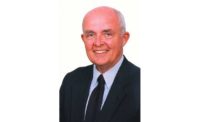Structural engineer Irwin G. Cantor, this year's ENR New York Legacy Award winner, died Nov. 7. He was 90 years old.
Cantor's career spanned 66 years. During that time, he built an international practice—initially named the Office of Irwin G. Cantor in 1971, and renamed the Cantor Seinuk Group (CSG) in 1992. He was well-regarded for his integrity, intelligence, decency, compassion, charm, diplomacy, humor and service to the public and the profession.
"He was a great mentor for three generations of design and construction professionals," says Bruce Phillips, senior managing director for developer Tishman Speyer, a 19-year client of Cantor's.
In the area of professional service, Cantor was instrumental in the development of New York City's code for high-strength 6,000-psi concrete, which he adapted from the Chicago code, after first introducing it on Manhattan's Helmsley Palace Hotel, built in the 1980s. He also led the development of the city's first seismic code, its structural peer-review requirements and the latest revision of the code's structural provisions.
In addition to the Helmsley Palace, Manhattan's Trump Tower and the so-called Lipstick building are among Cantor's high-profile structures.
In 1998, after he left CSG (currently part of WSP), Cantor hung out his shingle as a consultant to developer Tishman Speyer and other firms, guiding their building teams to design and construct better and more-efficient structures.
Cantor was still advising Tishman Speyer at the time of his death. He had no plans to retire. "We will never be able to replace him," says Charles A. DeBenedittis, Tishman Speyer's senior adviser for design and construction and the man who gave Cantor his first break on a high-rise, Manhattan's 919 Third Avenue.
"Irwin always had the sharpest mind in the room," adds Phillips. "He was able to come up with clever solutions to difficult problems.
"Irwin kept us out of trouble and got us out of trouble on structural projects around the globe," Phillips says.
Once, on a high-rise project, Cantor helped Tishman Speyer come up with an effective way to deal with a shifting slurry wall and helped build consensus among the design professionals, the construction team and Tishman Speyer.
For 23 years, until a few months ago, Cantor also served on the New York City Planning Commission. He was the longest-serving commissioner.
A Big Impression
Raised in the Astoria section of the New York City borough of Queens, Cantor spent hours as a boy watching the nearby construction of the Triborough Bridge. The project made a great impression on him.
After 15 months in the U.S. Air Corps, he entered City College and studied engineering. He picked civil engineering over mechanical or electrical because "you can't see heat transfer or electricity going through a wire," he said.
In a book of tributes compiled by his three daughters for his 80th birthday, a structural engineer and former competitor wrote: "You are a hero, and a mover and shaker of our profession. [Your office thrived because of your] talents, contacts, personality, engineering and CHUTZPAH."




Post a comment to this article
Report Abusive Comment